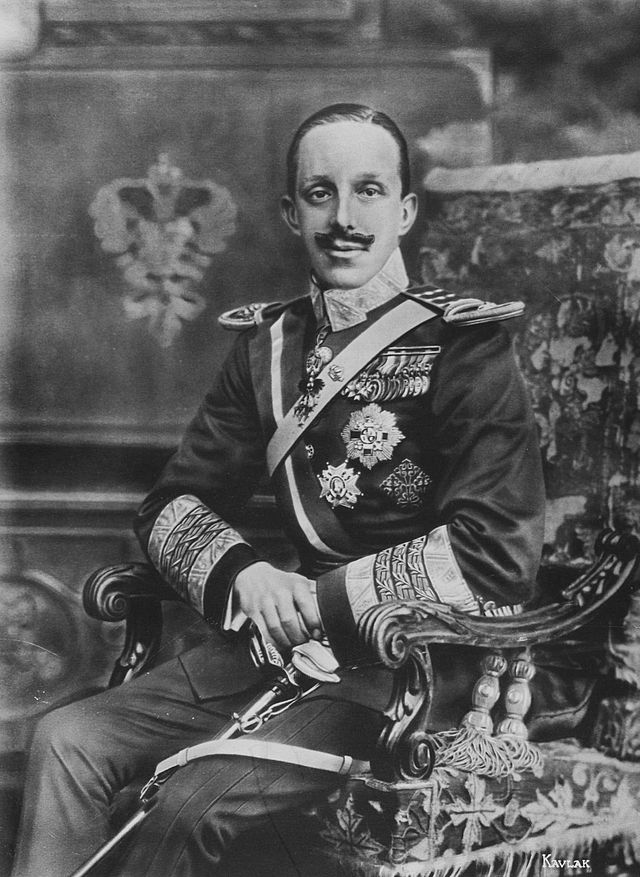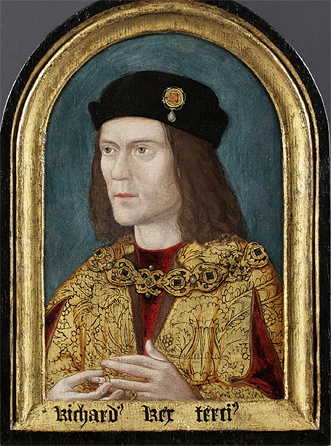© Unofficial Royalty 2024

King Alfonso XIII of Spain; Credit – Wikipedia
May 17, 1727 – Death of Catherine I, Empress of All Russia, at the Catherine Palace at Tsarskoye Selo, Russia; buried at Peter and Paul Cathedral in Saint Petersburg, Russia
Born Marta Helena Skowrońska, Catherine was the daughter of Samuil Skowroński, an ethnic Polish Roman Catholic peasant. She was the second wife of Peter I (the Great), Emperor of All Russia. Catherine and Peter had Catherine and Peter had twelve children, all of whom died in childhood except Anna, who died in childbirth at age 20, and Elizabeth, Empress of All Russia. Catherine became Empress in her own right after Peter’s death in 1725. During her short reign, Catherine was happy to leave the job of governing to her advisers. She was interested only in issues regarding the navy as Peter’s love for the sea had also touched her. Catherine’s health was adversely affected by living a difficult life, giving birth to twelve children, having a venereal disease that she contracted from Peter, and her heavy drinking after Peter’s death. 43-year-old Catherine died of tuberculosis in 1727.
Unofficial Royalty: Catherine I, Empress of All Russia
May 17, 1758 – Birth of Prince Honoré IV of Monaco in Paris, France
In 1777, Honoré IV married the wealthy heiress Louise d’Aumont, Duchess of Mazarin, Duchess of Mayenne, and Duchess of Meilleraye in her own right. The couple had two sons, both sovereign Princes of Monaco. The French Revolution had dire consequences for the Grimaldi family. Honoré IV and other members of his family were imprisoned. Honoré IV, whose chronic ill health had been worsened by imprisonment, would have become Prince of Monaco but Monaco was no longer a sovereign monarchy as France had annexed it. After Honoré IV’s release from prison, Louise and Honoré IV’s marriage became unhappy and the couple divorced. separated. Eventually, the right to rule Monaco was returned to the Grimaldis. By the time Honoré IV became the Sovereign Prince of Monaco in 1814, his physical condition had worsened and he was now paralyzed on one side of his body. Because of his condition, a regency was established to rule in his name. Honoré IV, Prince of Monaco died in Paris, France on February 16, 1819, aged 60.
Unofficial Royalty: Honoré IV, Prince of Monaco
May 17, 1768 – Birth of Caroline of Brunswick, Queen of the United Kingdom, wife of King George IV of the United Kingdom, in Brunswick, Duchy of Brunswick-Wolfenbüttel, now in Lower Saxony, Germany
Full name: Caroline Amelia Elizabeth
Caroline was chosen as the bride of her first cousin, the future King George IV. Great Britain was at war with revolutionary France and eager to obtain allies on the European mainland. This marriage is one of the worst ever royal marriages. Upon first seeing Caroline, George said to his valet, “Harris, I am not well; pray get me a glass of brandy.” Caroline said George was fat and not as handsome as his portrait. It is doubtful that the couple spent more than a few nights together as husband and wife. Their only child, Princess Charlotte of Wales, was born nine months later. Caroline and George both found each other equally unattractive and never lived together nor appeared in public together.
Unofficial Royalty: Caroline of Brunswick, Queen of the United Kingdom
May 17, 1802 – Death of Sophie Antonia of Brunswick-Wolfenbüttel, Duchess of Saxe-Coburg-Saalfeld, wife of Ernst Friedrich, Duke of Saxe-Coburg-Saalfeld, in Coburg, Duchy of Saxe-Coburg-Saalfeld, now in Bavaria, Germany; buried in the ducal crypt at the Morizkirche (or Stadtkirche St. Moriz) in Coburg, Duchy of Saxe-Coburg-Saalfeld, now in Bavaria, Germany
Sophia Antonia was the wife of Ernst Friedrich, Duke of Saxe-Coburg-Saalfeld, and the great-grandmother of Queen Victoria and her husband Prince Albert. She had connections to many royal families. She was the paternal aunt of Ivan VI, Emperor of All Russia, first cousin of Maria Theresa, Archduchess of Austria, and Queen of Hungary, Croatia, and Bohemia, and first cousin of Peter II, Emperor of All Russia. Because she was related to many royal families, Sophie Antonia was considered as a bride for several princes. However, she was not considered attractive causing the failure of many marriage negotiations. In 1749, she married Ernst Friedrich, the future Duke of Saxe-Coburg-Saalfeld. The couple had seven children but only three survived childhood
Unofficial Royalty: Sophie Antonia of Brunswick-Wolfenbüttel, Duchess of Saxe-Coburg-Saalfeld
May 17, 1886 – Birth of King Alfonso XIII of Spain in Madrid, Spain
Full Name: Alfonso Leon Fernando Maria Jaime Isidro Pascual Antonio
Alfonso is noteworthy because he became the King of Spain at birth. His father died while his mother was pregnant. In 1906, Alfonso married Princess Victoria Eugenie of Battenberg (Ena), the daughter of Princess Beatrice, Queen Victoria’s youngest child. He had decided to marry Ena despite the risk that she was a hemophilia carrier. Victoria Eugenie’s brother Leopold suffered from the disease. Alfonso and Ena’s marriage was strained from the birth of their first son, Alfonso. Shortly after his birth, it was discovered that he was suffering from hemophilia. Of their children, only their oldest and youngest sons had the disease. Despite knowing the possible risk before the marriage, Alfonso blamed Ena for bringing the disease into the royal family and distanced himself from her. He had several mistresses and fathered at least 6 illegitimate children. In 1931, elections were held, resulting in the establishment of the Second Spanish Republic. Alfonso and his family fled Spain, settling in France and then Italy. Soon after going into exile, Alfonso and Ena went their separate ways. He remained in Rome, while Ena settled in Switzerland. On January 15, 1941, feeling that his life was ending, Alfonso formally abdicated in favor of his third son, Juan, Count of Barcelona (the father of the future King Juan Carlos I of Spain). His two older sons had both renounced their claims to the throne in the early 1930s. Just weeks later, on February 28, 1941, King Alfonso XIII died at the Grand Hotel in Rome, Italy at the age of 54.
Unofficial Royalty: King Alfonso XIII of Spain
May 17, 1889 – Death of Marie of Prussia, Queen of Bavaria, wife of King Maximilian II of Bavaria, at Hohenschwangau Castle in Hohenschwangau, Kingdom of Bavaria, now in Bavaria, Germany; buried at the Theatinerkirche in Munich, Kingdom of Bavaria, now in Bavaria, Germany
In 1842, Marie married the future King Maximilian II of Bavaria. The couple had two sons, King Ludwig II and King Otto. Both of Marie’s sons were thought to have suffered from mental illness that severely hampered their abilities to rule Bavaria. After her husband’s death in 1864, Marie lived in relative seclusion, splitting her time between her country home in Elbigenalp and Hohenschwangau Castle in Füssen, Kingdom of Bavaria, now in the German state of Bavaria. In 1883, her elder son, King Ludwig II, was deemed incompetent, and Marie’s brother-in-law, Prince Luitpold of Bavaria, was appointed Prince Regent. Days later, King Ludwig II and his doctor were found dead in a lake, and Marie’s younger son became King Otto I, also under the Regency of Prince Luitpold. Marie died at Hohenschwangau Castle on May 17, 1889, aged 64.
Unofficial Royalty: Marie of Prussia, Queen of Bavaria
May 17, 1891 – Birth of Princess Alexandra, 2nd Duchess of Fife, Princess Arthur of Connaught at East Sheen Lodge in Richmond, London, England
Full name: Alexandra Victoria Alberta Edwina Louise
Alexandra was the eldest surviving child of Princess Louise, Princess Royal and Alexander Duff, 1st Duke of Fife, and a grandchild of King Edward VII of the United Kingdom. She married her first cousin once removed, Prince Arthur of Connaught, the only son of Prince Arthur, Duke of Connaught. After her father’s death, Alexandra became the Duchess of Fife in her own right.
Unofficial Royalty: Princess Alexandra, 2nd Duchess of Fife, Princess Arthur of Connaught
May 17, 1926 – Birth of Prince Dmitri Romanov, at the villa of his grandfather Grand Duke Peter Nikolaevich of Russia in Antibes, France
Prince Dmitri Romanov, a great-great-grandson of Nicholas I, Emperor of All Russia, was one of the disputed pretenders to the Headship of the Russian Imperial Family from 2014 – 2016.
Unofficial Royalty: Prince Dmitri Romanov
May 17, 1951 – Death of Empress Teimei of Japan (born Lady Sadako Kujō), wife of Emperor Taishō of Japan, at Omiya Palace in Tokyo, Japan; buried at the Musashi Imperial Graveyard in Tokyo, Japan
The future Emperor Taishō, had cerebral meningitis when he was three weeks old and this affected his health and his mental capacity, including a speech disorder and difficulty walking, for the rest of his life. Due to his health issues, he was often unable to continue his studies and he was a poor student in areas requiring higher-level thinking. Because of Taishō’s diminished mental capacity, his father Emperor Meiji wanted an intelligent, articulate, and dignified wife for his son, and he found those qualities in Lady Sadako Kujō.
Unofficial Royalty: Empress Teimei of Japan
May 17, 1971 – Birth of Queen Máxima of the Netherlands, wife of King Willem-Alexander of the Netherlands, born Máxima Zorreguieta Cerruti in Buenos Aires, Argentina
Máxima met her future husband in Spain, during the Seville Spring Fair. At first, she was unaware of his royal status, having introduced himself as ‘Alexander’. When he eventually told her who he was, she thought he was joking. They met again a few weeks later in New York and their romance blossomed. The couple married on February 2, 2002. Máxima and Willem-Alexander have three daughters. Willem-Alexander’s mother Queen Beatrix abdicated on the morning of April 30, 2013, and Willem-Alexander became the new King of the Netherlands and Máxima became Queen. Queen Máxima holds numerous public posts and represents the Royal House at official occasions. She is a member of the Council of State which provides the government and Parliament with advice on legislation and governance and is also the country’s highest administrative court.
Unofficial Royalty: Queen Máxima of the Netherlands
This article is the intellectual property of Unofficial Royalty and is NOT TO BE COPIED, EDITED, OR POSTED IN ANY FORM ON ANOTHER WEBSITE under any circumstances. It is permissible to use a link that directs to Unofficial Royalty.




























